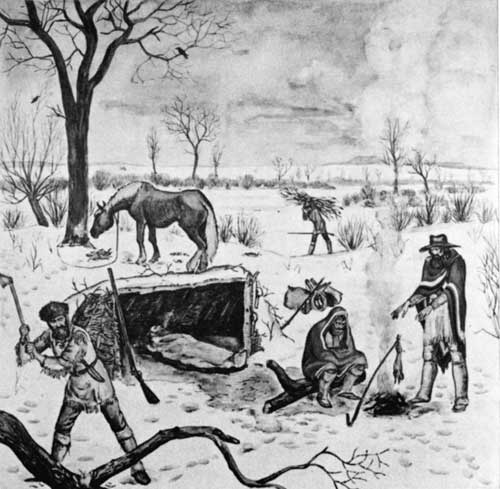|
SCOTTS BLUFF National Monument |
 |

Returning Astorians at Scotts Bluff Christmas
Day, 1812.
Original sketch in Oregon Trail Museum.
First White Men at Scotts Bluff
Fur traders were the first white men known to have seen Scotts Bluff. They were the returning Astorians—a group of seven men under Robert Stuart, traveling from their trading post at the mouth of the Columbia River to St. Louis. On Christmas day, 1812, Smart recorded in his journal:
21 miles same course brought us to camp in the bare Prairie, but were fortunate in finding enough of driftwood for our culinary purpose. The Hills on the south have lately approached the river, are remarkably rugged and Bluffy and possess a few Cedars. Buffaloe very few in numbers and mostly Bulls.
The Astorian Expedition of 1811, so-called because it was an enterprise of the wealthy fur trader, John Jacob Astor, comprised the second group of Americans to span the continent. Led by Wilson Price Hunt, the "Astorians" ascended the Missouri River until they were blocked by the treacherous Arikara or "Ree" Indians near the mouth of Grand River. Then they traveled overland, skirting the Black Hills and the Bighorn Mountains, and reached their Columbia River headwaters via Jackson Hole. Joining forces with another Astor group who had reached the mouth of the Columbia by ship, they built Astoria, the first American trading post on the Pacific slope. In 1812, Robert Stuart and his small band started back overland to carry messages to Astor. By their successful mission they performed one of the great feats of western exploration, for in their perilous journey eastward they blazed the route via the Upper Snake, Green, and North Platte Rivers which was destined to become the Oregon Trail! (See map.)
Constantly imperiled by exposure, starvation, and Indians, they crossed the Continental Divide near South Pass and descended the Sweetwater and North Platte Rivets. After they had passed Scotts Bluff, the hostility of the wintry Plains impelled them to retrace their steps to a point near present Torrington, Wyo., where they camped for the winter and built canoes. Early in the spring of 1813 they resumed their journey. They were unable to navigate the shallow, braided, upper reaches of the Platte River, and it was not until they reached Grand Island, that they successfully launched their canoes.

|

|
|
Last Modified: Sat, Dec 9 2000 10:00:00 am PDT |


